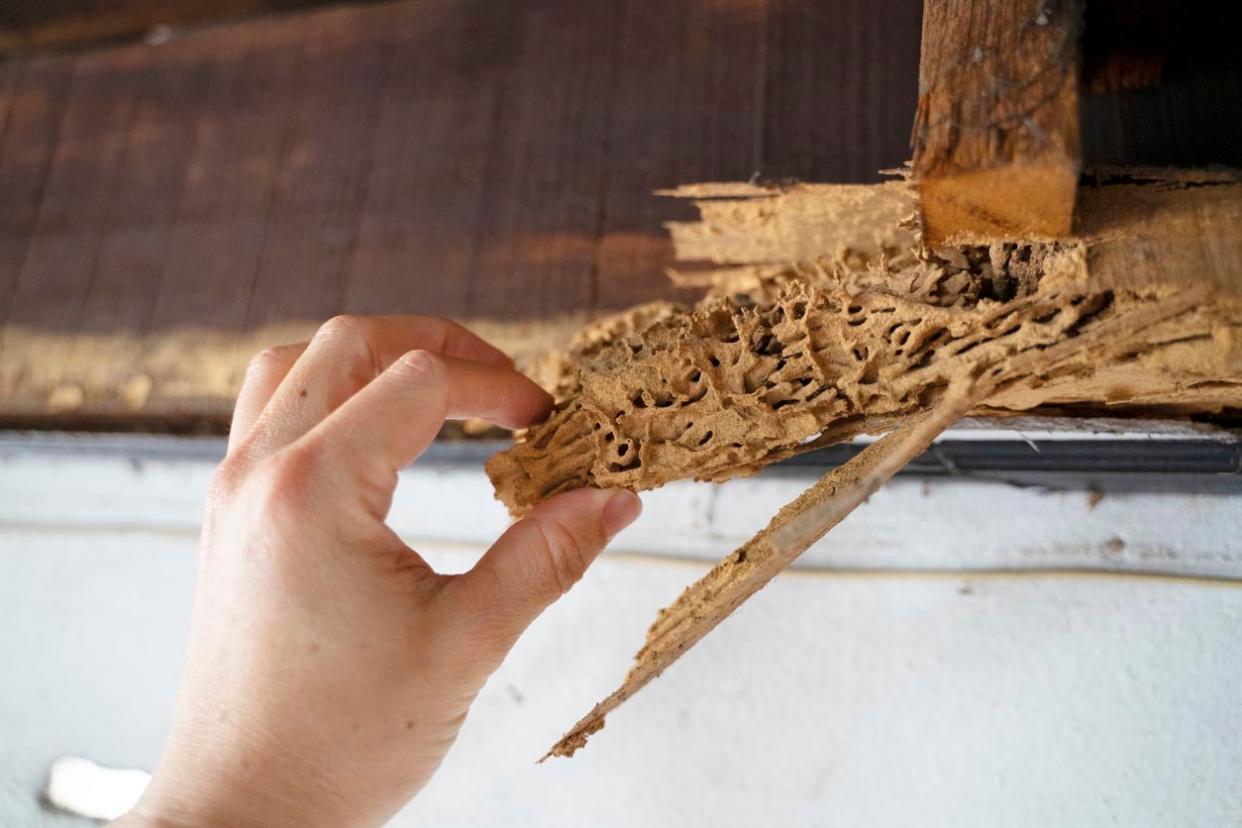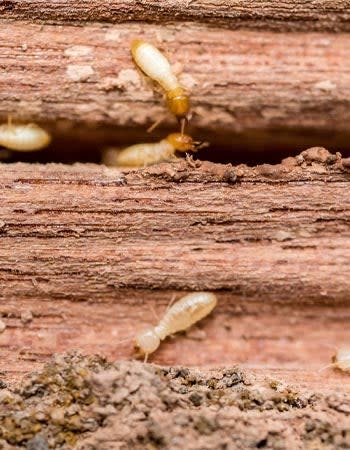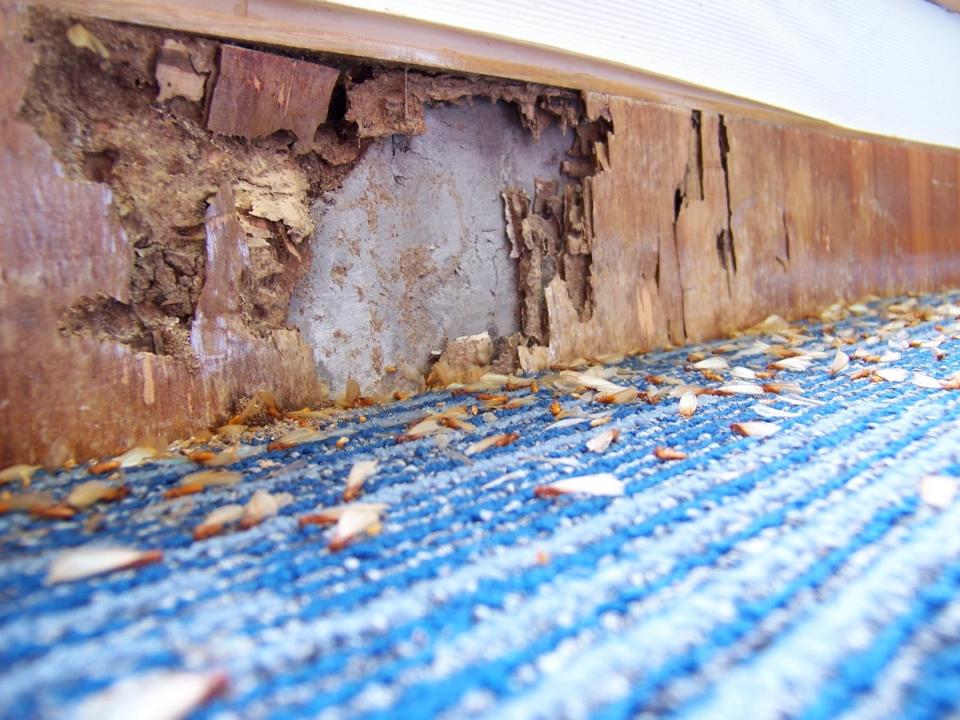Solved! What Does Termite Damage Look Like?

Q: Lately, my doors and windows are hard to open, and I’ve noticed small piles of wood around the house. What does termite damage look like? Should I contact someone to perform an inspection?
A: Unfortunately, windows and doors that are hard to open and small piles of wood are two signs of a termite infestation. However, before a homeowner starts to panic, it helps to get a clear understanding of what termite damage looks like, because it can differ based on the geographic location of the home and the species of termite that may be present. A homeowner may also wonder how to look for termite damage or what termites look like, and the guide below can help answer those questions. Those who are still unclear on what early-stage termite damage in drywall looks like or how to spot termites may want to contact a professional termite control specialist.
Termite damage can present itself in different ways, including stuck windows and doors or piles of termite frass (droppings).

Photo: istockphoto.com
Termites themselves can infest a home without homeowners even spotting them, which is why it’s so helpful to know the signs of infestation before the problem gets too big. The most common signs of termite damage include the following:
clicking sounds coming from the walls;
discarded wings around the house;
hollow-sounding wood;
windows or doors that are hard to open; and
evidence of mud tubes.
One or more of these signs is enough to call in the help of a professional to perform an inspection and come up with a treatment and repair plan.
Termite-damaged wood can sound hollow when it’s tapped or knocked.
Because most termites feed on the cellulose found in wood, the tunnels and galleries they create make the wood hollow. To test a wood structure to hear if it sounds hollow, a homeowner can probe the area in question with the back end of a tool, like a screwdriver or hammer. If, after tapping the wood, the homeowner hears a rich, deep sound, they likely don't have a termite- infested house. However, if it’s a high-pitched or empty sound, a homeowner may want to investigate further by calling a termite control specialist.
If the wood sounds hollow, a termite expert will likely probe the area further or take moisture readings to see if there are other signs of termite damage. To get the most accurate picture of what is present, an inspector may also remove a baseboard or piece of molding to see if any termites or other evidence of termites is present.
Subterranean termites create mud tubes on a home’s exterior and typically enter a home near its foundation.
Also called mud tunnels, mud tubes are small, pencil-size paths that termites make out of small pieces of wood and soil. They’re usually found around a home’s foundation and help protect the harmful insects from predators while they move around. These structures also block out dry air, which makes the area ideal for subterranean termites, since they prefer spaces with high humidity.
If a homeowner spots mud tubes near the foundation of the home or by a wooden structure or tree, it’s best to contact a termite control expert, since mud tunnels are one of the main signs of a subterranean termite infestation. Mud tubes are essentially termite trails, which can help a professional identify their nest or spots where they’ve inflicted damage to the home.
Find trusted local pros for any home project

+

Dampwood termites are found in or near decaying or rotting wood and typically chew wood along the grain.
As their name suggests, dampwood termites prefer moist, rotten wood, since they thrive in areas with heavy moisture. About ½ to 1 inch long, these bugs are bigger than drywood or subterranean termites; however, their colonies are often the smallest. They don’t create shelter tubes like subterranean termites do; instead, they live completely inside the wood they feed on.
Dampwood termite evidence includes wood that sounds hollow when tapped, soft or squishy wood, and a lack of termite frass. Because dampwood termites survive best in high humidity, they use their droppings to plug any holes or openings in the wood they inhabit. Homeowners can usually find these insects in western states such as California, Washington, Oregon, Nevada, Montana, and Idaho.
As their name suggests, drywood termites infest dry wood, and their damage has a smooth, sculpted appearance.
Unlike dampwood termites, drywood termites don’t need moist wood to survive. Instead, they tend to infest drier wood in home structures like attic rafters. Secondhand wooden furniture can also house drywood termites. This species of termites is commonly found above ground level on the West Coast, in Hawaii, and in Florida. Drywood termites’ galleries or nests typically have a smooth, sculptured appearance. These galleries can often contain termite droppings.

Photo: istockphoto.com
Carpenter ant infestation and wood rot can also resemble termite infestation signs.
Saggy floors, weakened beams, and other signs of structural instability can be the work of both termites and carpenter ants. Like termites, carpenter ants are attracted to moisture, since it provides them with an ideal place to nest and forage. The main difference between carpenter ants and termites, however, is that carpenter ants don’t eat wood but instead excavate galleries to make nests. This is where a homeowner might see evidence of sawdust. A homeowner may think this is damage by termites when it’s really havoc wreaked by determined ants. However, it’s still wise to get this damage investigated by a pro and have the infestation treated.
Wood rot can also look like termite damage, but there are some differences that can help homeowners tell the two apart. For starters, wood rot is often spongy and crumbly and is darker in appearance than termite wood damage. Wood rot also occurs in areas with excess moisture or exposure to water, likely in areas that are closer to the ground. In the case of termite damage vs. wood rot, a homeowner is less likely to find bugs in wood rot, whereas bugs will always be around when there’s termite damage.
When in doubt, it’s best to find a trusted termite control expert to take care of termite problems.
Although termites are tiny, they can cause massive damage to a home’s structure. Even if a homeowner sees only a few of the signs listed above, it’s best to contact one of the best termite companies such as Terminix. A professional can assess the home and see what kind of damage has been done. They’ll know how to get rid of termites so they don’t return and see that any damage is repaired. A professional in the termite field can also advise a homeowner on preventive measures they can put in place moving forward.
Termite treatment can cost anywhere from $221 to $916, depending on the extent of the infestation or the type of termite that is present. Those unsure about whether they have an actual infestation can contact an expert to provide a termite inspection, which costs about $100 on average. Once the homeowner has had their home inspected and treated, the next step is repairing termite damage. Depending on the extent of the damage, the cost to repair termite damage is typically $600 to $3,000.
FAQs
From whether paint can protect untreated wood to what the most effective termite treatment is, the answers to homeowners’ burning questions can be found below.
Q. What is the most effective treatment for termites?
The most effective treatment for termites is fumigation, which involves tenting off the infested area and dispensing sulfuryl fluoride gas into the air to kill termite colonies.
Q. Can I get sick from wood rot?
Wood rot itself doesn’t cause sickness; however, the conditions that lead to wood rot can also harbor mold, which can affect the respiratory system.
Q. Do termites go after dry wood?
They do if they’re drywood termites, which are rarer but still present in the United States.
Q. Will paint protect untreated wood from termites?
No, paint will not protect untreated wood from termites.
Q. How fast will untreated wood rot?
Untreated wood will take anywhere from 1 to 6 months to show signs of rotting.


